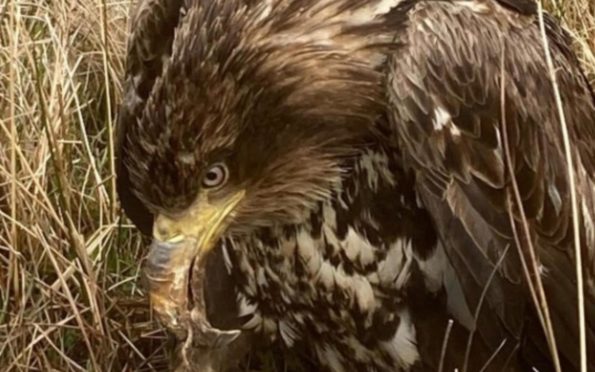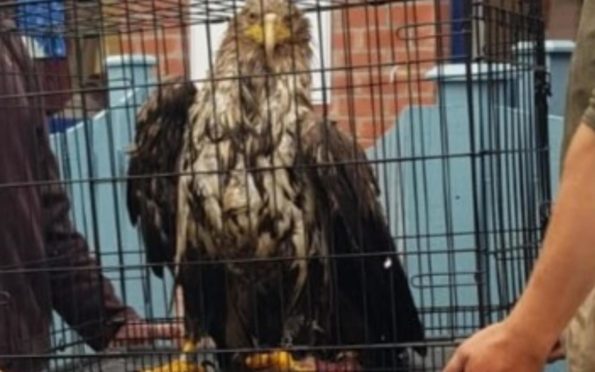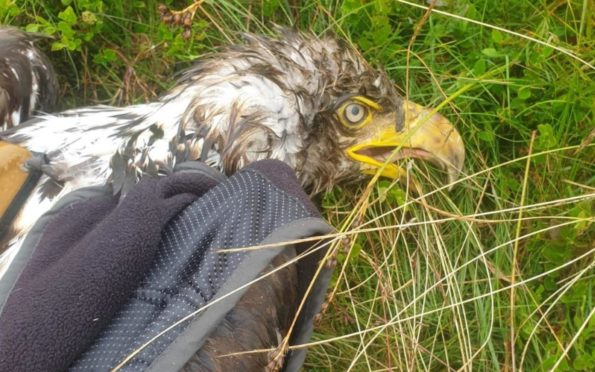A white-tailed eagle which was rescued by a Highland Perthshire gamekeeper has been nursed back to health in the hopes it will one day take to the skies again.
The gamekeeper came across the sea eagle as he performed his morning tasks, finding it grounded and in a poor condition.
Back in June, the same bird had been rehabilitated by the Scottish SPCA after it came to the attention of staff on an Argyll estate who notified Scotland’s nature advisers, NatureScot.
The eagle was captured so it could be treated and it was found to be suffering from dehydration and a malformed beak, which can cause birds problems in the wild.
Gamekeeper steps in to save ailing eagle
Gamekeepers in Perthshire were asked to look out for the bird by NatureScot after its tag, fitted by them, indicated that the bird had recently moved into the area.
Tayside and Central Scotland Moorland Group members kept a look-out for the three-year-old eagle which initially appeared to be ranging in west Perthshire and causing little concern.
However, that changed early on Tuesday morning when a local gamekeeper, who does not wish to be named, found the grounded eagle during his chores on a local grouse moor and instantly became fearful for its survival.
The bird was wet and not moving and seemed to be in a poor condition.
Concerned for its wellbeing, he carefully captured the bird and gave it sustenance and shelter, before delivering it to Crieff Vets.
It is understood the bird will now be cared for by Scottish SPCA with the hope that it can be rehabilitated and re-released once again in the future.
White-tailed eagles, or sea eagles, were reintroduced to Scotland and have been hailed as a conservation success, with an estimated 150 breeding pairs now resident.
They became extinct in the 1900s but were successfully reintroduced after chicks were brought from Norway.
Alice Bugden, co-ordinator of the Tayside and Central Scotland Moorland Group, said: “When we were informed about the bird, the local gamekeepers and shepherds kept an eye out for it.
“We were told, in conversations with NatureScot, that it still seemed to be moving so that was good.
“However, it was then found in a poor condition by one of the keepers and he knew something had to be done.
“He didn’t know how much longer it would survive for without veterinary attention.
“He doesn’t want to be named because he was just doing what anyone else would do in the circumstances.
We hope it can be treated, will survive and can take to the skies again.
“We hope it can be treated, will survive and can take to the skies again.
“It is a good example of what can be achieved through dialogue between nature bodies and working land managers.”
When the eagle was treated in Argyll in June, with assistance from estate staff and the local vet, it was confirmed as healthy enough to be returned to the wild.
NatureScot fitted the satellite tag as part of ongoing work related to the White-Tailed Eagle Action Plan.
‘Quick thinking’ gives eagle better chance of survival
It was hoped that the data this tag collects would help inform ongoing work on white-tailed eagle predation of lambs should the bird eventually establish a territory in Argyll, where this is an ongoing issue.
Andrew Kent, who manages the Sea Eagle Management Scheme for NatureScot, added: “We would like to thank the gamekeeper and the Tayside and Central Scotland Moorland Group for their assistance in this case.
“Thanks to their quick thinking and communication this sea eagle now has a better chance of survival.
“The bird is now being cared for by the Scottish SPCA and we hope it will make a full recovery and be released into the wild again.
“This is a great example of where organisations can work together for the benefit of biodiversity.”


